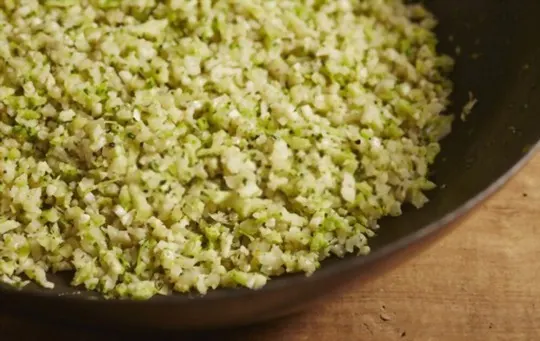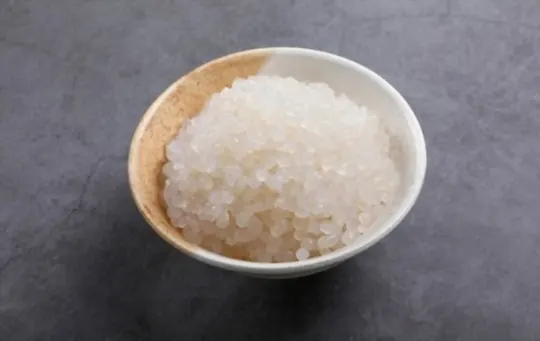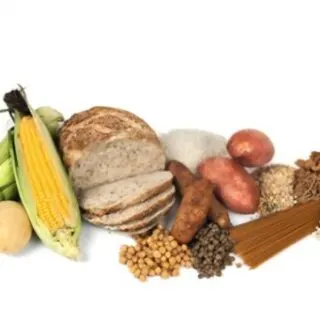Are you a diabetic concerned about the potential health risks of eating rice? Don’t worry.
This article offers vital information on managing diabetes through the 5 best rice substitutes that offer similar nutrition, taste and texture.
Get ready to learn the safest ways to enjoy your favorite dishes with diabetes-friendly options.
Rice and Diabetes: How Great is the Risk?

Rice has been associated with an increased risk of type 2 diabetes in some studies.
But the question is, how great is the risk associated with consuming rice?
Recent studies suggest that serving a variety of grains and limiting intakes of highly refined grains such as white rice, can reduce diabetes risk.
Other research suggests that whole grain rice consumption may be protective against type 2 diabetes.
So consuming varied sources of whole grains should be encouraged for people wanting to reduce their diabetes risk.
The Glycemic Index (GI) of a rice product is determined by the degree to which the carbohydrates are broken down during storage and cooking and this affects how quickly and quickly the carbohydrates are digested.
Most white, long-grain rices have a GI value greater than 70, which corresponds to “high glycemic” and can cause significant fluctuations in blood sugar levels; on the contrary, brown (long-grain) rices tend to have medium GI values which don’t trigger such an intense increase in blood sugar levels.
Consumption of white, long-grain rices should therefore be limited or avoided, especially by people where diabetes runs in their family or who present high glucose levels in their fasting tests results.
Risk factors include age (> 45 years old), ethnicity (Asian or Hispanic/Latin American), family history; obesity (> 25).
Can Diabeties Eat Rice?
Rice is a staple food for many people around the world and is an important source of nutrition for those with diabetes.
While it has been suggested that eating white rice increases the risk of developing type 2 diabetes, this has not been proven in human clinical trials.
While white rice may have a higher glycemic index (GI) rating, that does not necessarily mean it will cause an increased risk of diabetes in individuals.
It is important to remember that it’s not just white rice, but also processed grains like breads and pastas, which can also increase the risk of type 2 diabetes due to their high GI value.
Therefore, diabetics should take precautions when eating these kinds of foods by opting for whole-grain versions that are naturally lower in GI than their processed counterparts.
In addition to whole grains, there are many other options available for diabetics which can help them maintain healthy blood sugar levels while still enjoying the foods they love.
These alternatives include quinoa and other gluten-free grains like amaranth, bananas (a starchy fruit), lentils, beans, legumes (e.g., chickpeas and kidney beans).
Additionally, healthier substitutes like cauliflower “rice”—made by grating freshly cut cauliflower—can be used as a substitute for white or brown rice in many recipes due to its low carbohydrate content and neutral flavor profile.
Finally there is black or wild rice which contains both soluble and insoluble fibers making them a great source for managing blood sugar levels as well as providing antioxidants which help support good overall health.
5 Best Rice Substitutes for Diabetics & Diabetic Rice Alternatives
Diabetes is a serious health condition that has been on the rise due to increasing rates of obesity and poor lifestyle choices.
Consuming too much of starchy carbs, including rice, can spike blood sugar levels.
That’s why it’s important for people with diabetes to monitor their carbohydrate intake and substitute high-carb foods with healthier alternatives.
Fortunately, there are a number of riceless options which provide similar taste and texture as traditional rice that won’t spike your blood sugar levels.
Here are five great rice substitutes for diabetics:
1 – Riced Cauliflower

Riced cauliflower is one of the most popular “rice” substitutions out there.
Nutritionally speaking, it’s nearly a perfect replacement, as a one-cup serving contains only 25 calories, 5 grams of carbohydrates and 2 grams of dietary fiber.
It’s also naturally low in fat and sodium – bonus.
Cauliflower is great for diabetics because it helps to provide essential vitamins and minerals without boosting blood sugar levels.
Riced cauliflower can be substituted for rice in any recipe — from stir-fries to casseroles — making it a surprisingly versatile option for type 2 diabetics.
It’s easy to find pre-riced cauliflower at many major grocery stores or you can prepare your own by grating fresh florets on the smallest side of a cheese grater or pulsing them briefly in a food processor.
For best results, avoid microwaving riced cauliflower to retain as much nutrients as possible.
2 – Riced Broccoli

Riced broccoli is becoming increasingly popular as a healthier alternative to white rice and other starches.
Broccoli is an excellent source of fiber, vitamins C and K, as well as B vitamins.
It also provides iron, manganese, phosphorus and zinc.
In terms of nutrition alone, riced broccoli beats out other rices like brown and white.
Studies suggest that consuming certain cruciferous vegetables such as broccoli can reduce the risk of diabetes and improve glucose control in those with diabetes.
As a low-calorie food, it’s also a great choice for weight loss.
In terms of taste, the mild flavor of broccoli can easily be enhanced with some garlic or lemon juice or even added to favorite recipes.
Whether steamed, boiled or microwaved you can get creative with this delicious low-glycemic option.
3 – Shirataki (Miracle Rice)

Shirataki is a type of miracle rice — this translucent, gelatinous rice has zero digestible carbohydrates, making it an ideal choice for diabetics.
It’s made from the root of the konjac plant and comes in a variety of shapes and sizes including noodles, ravioli and even pizza crusts.
Shirataki has a chewy texture that’s similar to al dente pasta or ramen noodles, but with no carbs or calories.
It can be used in place of real rice oatmeal too.
Additionally, shirataki is high in fiber which can help balance your blood sugar levels when combined with whole grains.
Shirataki generally comes in packages that need to be rinsed before being cooked, so it doesn’t take long to prepare.
Combine it with your favorite sauces and veggies as a delicious side dish or main course.
4 – Quinoa

Quinoa is gaining popularity for its nutritional benefits and is a great substitute for rice for diabetics.
This South American grain-like crop is packed with fiber, protein, minerals and vitamins as well as antioxidants that can help fight disease.
Quinoa has a lower glycemic index than white rice, so it helps to keep blood sugar spikes low and regulate insulin levels.
It also contains complex carbohydrates which break down slowly in the body, helping to maintain a healthy glycemic level over a longer period of time.
Quinoa can be prepared in many different ways and can be used as an accompaniment to other dishes or as a side dish.
5 – Whole-grain Farro

Whole-grain Farro is an ancient form of wheat and an excellent replacement for rice in any dish.
It cooks quickly and has a nutty flavor as well as chewy and fluffy grain at the same time.
In comparison to white rice, Farro is lower on the glycemic index, higher in fiber, and has much more protein, minerals like zinc and iron, vitamins like B-6, B-3 and folate which are all important for gut health.
All of these components make it a great food for controlling blood sugar levels.
Plus, it’s versatile: You can use it in pilafs, stir-fries or salads to get creative with your meal options.
Conclusion
It is important to remember that although there is a possibility of increased blood sugar levels with rice consumption, this does not mean one should avoid rice altogether if they have diabetes.
The critical aspect to consider is portion size.
Eating smaller amounts of rice will have minimal impact on blood sugar levels and can still be enjoyed in the diabetic diet plan.
For those looking for alternatives to rice, these 5 best substitutes are worth considering: quinoa, barley, cauliflower “rice”, millet, and buckwheat.
Keep in mind that it is also important to consider other components in the diet when it comes to managing diabetes.
Maintaining a diet that includes moderate amounts of carbohydrates combined with pH balanced greens, healthy fats and proteins is an ideal approach for overall health and wellness.

5 Best Rice Substitutes for Diabetics u0026#038; Diabetic Rice Alternatives
Ingredients
- 1 – Riced Cauliflower
- 2 – Riced Broccoli
- 3 – Shirataki Miracle Rice
- 4 – Quinoa
- 5 – Whole-grain Farro
Instructions
- Choose your preferred substitute from the list of options.
- Organize all of your ingredients.
- Use the proper substitute to cook your recipes.

Carrie is a food writer and editor with more than 15 years of experience. She has worked for some of the biggest names in the food industry, including Bon Appétit, Food & Wine, and Martha Stewart Living.
As the Editor in Chief of IntroChicago.com, Carrie oversees all of the content on the site. She also manages the team of contributing writers and editors, who help to create delicious recipes, helpful tips, and informative articles that you’ll find on the site.
A native of the Chicago area, Carrie is passionate about all things food. She loves trying new restaurants and experimenting with new recipes in her kitchen. She’s also a graduate of the Culinary Institute of America, so she knows a thing or two about food!
